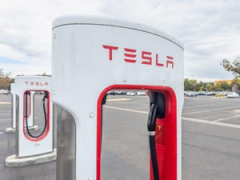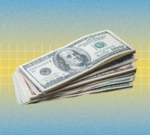Remember when it was a novelty to see a Prius or a Tesla on the road? Living in California, almost every second car I see these days is electric. EVs will become even more commonplace as some states begin outlawing the sale of new gas-guzzling cars over the next decade and people become more climate conscious.
Sales of electric vehicles are expected to make up 60% of all vehicle sales in the US, China and Europe by 2030. That means we’ll need charging stations to be as common as gas stations.
Right now, one of the biggest concerns when you’re deciding whether to buy an electric car is how often you’ll have access to a charger when you need one. No one wants to get stuck in the middle of nowhere with a dead battery.
Not only do you have to charge up your car when you get home, but take a long enough trip and you’ll also be stuck trying to find a charger on the road. Hence the term range anxiety.
Read more: What If Your EV Could Power Your Home During a Blackout?
With Tesla quickly becoming the dominant force in charging infrastructure on the road, carmakers globally are reaching agreements with the American EV company to make their own cars compatible with the Tesla Superchargers that are already widely available.
“This is going to be huge for range anxiety,” said Amaiya Khardenavis, research analyst at Wood Mackenzie, adding that there are now 34,000 fast chargers in the US and 60% of them are Tesla owned. “You can imagine the kind of reach they’ll get by using the network.”
Below, I’ll explain when the switch will happen, whether you’ll be able to use Tesla chargers with your EV, whether you’ll need to buy an adapter or if that EV you’ve been eyeing to buy will soon come with a Tesla port.
Different EV chargers: CCS vs. NACS
Right now, there are two main ways electric cars are charged: the Combined Charging System and the North American Charging Standard. Tesla devised NACS back in 2012, and in 2022, it announced it would allow other cars to use it.
The main technical differences between CCS and NACS? Tesla’s NACS connector is smaller and the cable is more lightweight, meaning it’s easier to plug in and charge your car. CCS chargers pack 350kW of power, and Tesla Superchargers 250kW.
Most importantly, though, there are around 19,000 ports with NACS connectors in the US, while there are around 10,000 ports with CCS connectors.
“The ability to access the Tesla Supercharger network increases choice and availability for non-Tesla EV drivers,” said Loren McDonald, CEO of analysis and insights group EVAdoption. “Tesla Supercharger stations often will have 12, 20 or more chargers with likely all of them working. Whereas many of the charging stations offered by other charging networks may only have four to eight chargers.”
Add to the greater availability of Tesla chargers the fact that a recent study in the San Francisco Bay Area found that CCS chargers were only functioning 72% of the time. Whereas Tesla has 99% uptime on its chargers, making them far more reliable.
And as demands increase on not only the number of chargers but also their capacity and speed, we’re only going to need them more and more. Read on for when the switch to Tesla charging is happening for every carmaker.
A line of Tesla Superchargers for charging electric vehicles in Manteca, California.
Stephen Shankland/CNETThe big switch
The switchover to NACS started with Ford CEO Jim Farley, according to McDonald. “He and his team were frustrated with the poor charging experience their Mustang Mach-E customers were having when charging at Electrifying America charging stations,” McDonald said. Solving the customer experience problem would mean selling more Ford EVs.
As a result, Ford partnered with competitor Tesla, and GM soon followed. The reality, McDonald said, is that automakers don’t want to invest in rolling out charging stations themselves. GM CEO Mary Barra said the Tesla deal would save the company up to $400 million.
So what’s in it for Tesla? “Tesla spun off the supercharger division into a separate entity and sees larger revenue generation opportunities as [a provider] like Electrify America or ChargePoint,” said Sandeep Mukunda, IDC research manager for digital automotive and transportation strategies. “Tesla still has a significant advantage over other brands in terms of in-vehicle tech and pricing, so it is not seen as a big threat.”
The question remains on whether charging will be as seamless with non-Tesla vehicles at Tesla charging stations. Khardenavis says we might see a hit in EV sales over the next two years, because why buy an EV now with an adapter instead of waiting until 2025 for the NACS charging built in?
“But hopefully it’s a net positive for the future,” Khardenavis said.
One hurdle remains: In President Joe Biden’s infrastructure bill passed in 2021, $7.5 billion was set aside to help fund a network of EV chargers across the US using the CCS standard. The federal government still requires CCS plugs at charging stations that wish to receive this federal funding.
Will you need an adapter? Will you have to pay for one?
Until new EVs are produced starting in 2025 with built-in compatibility with Tesla chargers, you will need an adapter to make the NACS plug fit into your car.
I spoke to several carmakers, but they’ve balked at saying whether you’ll have to pay for those adapters yourself, or whether they’ll be provided at the point of sale. If you already own an EV from another car manufacturer, chances are high you’ll be buying the charging adapter yourself, whether through Tesla or your car brand.
McDonald estimates it could cost between $175 and $250.
Will you have to pay to use Tesla chargers?
It’s a safe bet that you’ll have to pay to use Tesla chargers on the road, but the question is whether you’ll be paying more than Tesla owners to use them.
Tesla has reassured its drivers they’ll “have access to the lowest Supercharger pricing,” whereas non-Tesla drivers will see pricing that “reflects additional costs incurred to support charging a broad range of vehicles and adjustments to our sites to accommodate these vehicles.”
Tesla says you can lower the per kilowatt-hour price with a charging membership, though. You can check out all the pricing in the Tesla app on iPhone and Android.
How will you know where you can charge your EV?
Once your non-Tesla EV has either an adapter or charging port as standard, car companies will add Tesla chargers to their maps on your onboard car software and apps. You’ll be able to see all the additional sites where you can charge your EV safely.
When will the switch happen?
During 2024, carmakers will begin providing adapters for drivers of their current EVs. From 2025, new EVs will come equipped with Tesla charging ports built in.
See the sections below for who is making the switch and when.
Which EVs will switch to Tesla chargers?
Volkswagen
Volkswagen, which owns the Porsche, Bentley, Audi, Bugatti and Lamborghini brands, was the latest to announce plans on Dec. 19 for Volkswagen, Audi, Porsche and Scout EVs to have NACS charging ports implemented starting in 2025.
The company is also “exploring adapter solutions” for its existing EVs across the VW, Porsche and Audi brands from 2025.
“This potentially provides … access to more than 15,000 additional charging points as well as the current near 4,000 DC fast charging outlets operated by Electrify America,” said Pablo Di Si, CEO of Volkswagen Group of America.
Subaru
Subaru announced Nov. 1 that it had reached an agreement with Tesla to adopt NACS on its charging ports for vehicles launching from the beginning of 2025.
Until 2025, Subaru will provide its customers with access to a NACS adapter, which it said will give them access to more than 15,000 Tesla Superchargers in North America.
Toyota and Lexus
Toyota announced on Oct. 19 that “certain” EVs produced by Toyota and Lexus would have Tesla charging ports starting in 2025, including Toyota’s upcoming three-row electric SUV.
If you own an electric Toyota or Lexus that’s equipped with CCS, you’ll “b





